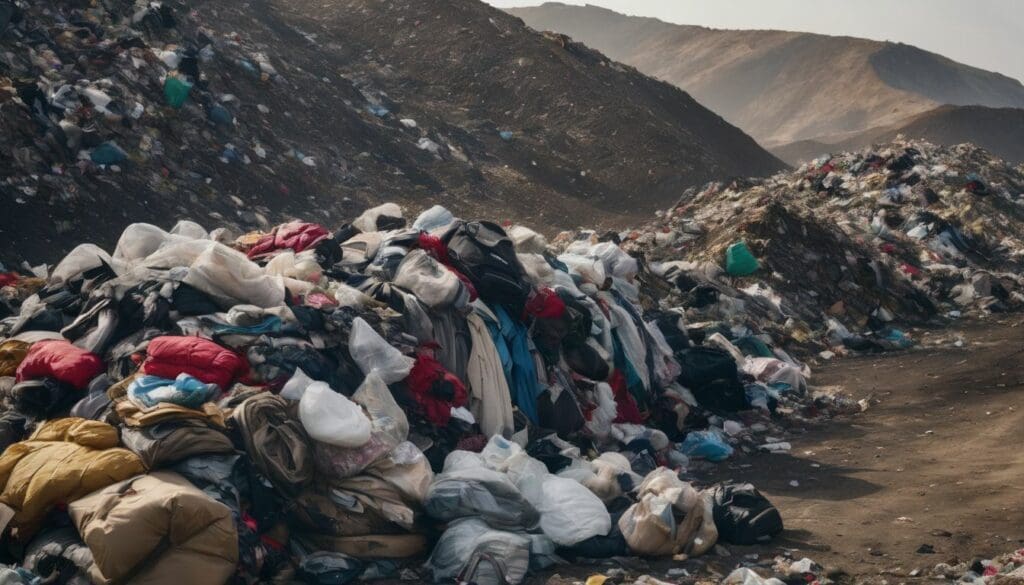We’re all quite keen on keeping up with the latest trends, aren’t we? Yet there’s a niggling concern at the back of our minds – what about the impact on our dear planet? Like many of you, we were rather taken aback to discover that the fashion industry is responsible for a staggering 10% of global carbon emissions.
That’s why our team has rolled up their sleeves and delved into sustainable options with gusto. We’re eager to share some down-to-earth steps that can lead us towards a more environmentally friendly wardrobe.
So stick around – after all, true change begins with small, conscious choices from each one of us!
Key Takeaways
- Fast fashion causes significant environmental damage, producing 10% of global carbon emissions and contributing to climate change.
- The industry’s practices lead to high water consumption, which results in water scarcity and affects local communities; it also creates microplastic pollution that harms marine life.
- Sustainable alternatives like the slow fashion movement and a circular economy for textiles can reduce environmental impact by focusing on recyclability, ethical production, and minimising waste.
Fast Fashion and Its Environmental Impact
Fast fashion refers to the rapid production and consumption of low-cost, trendy clothing. Unfortunately, this model has significant negative consequences for the environment.
Definition of fast fashion
Fast fashion refers to inexpensive clothing produced rapidly by mass-market retailers in response to the latest trends. This trend-driven approach means garments are often made quickly and cheaply to meet consumer demand for new, affordable styles.
As a result, we see an endless cycle of apparel hitting stores and online shops, encouraging us to buy more than we need.
This business model prioritises speed and low costs, leading to significant environmental impact. It relies on high-volume production which increases textile waste; clothes become disposable after only a few wears.
Our environment pays the price as landfills swell with discarded garments, carbon emissions rise from rapid manufacturing processes, and pollution spreads due to unsustainable practices in material sourcing and production.
We’re facing a climate crisis where fast fashion plays a detrimental role, urging us all towards more sustainable choices in our wardrobe selections.
Negative consequences
After understanding the definition of fast fashion, we must comprehend the severe negative consequences it presents for the environment. Fast fashion contributes to an alarming amount of textile waste and pollution, leading to significant harm in landfills and incinerators.
This results in a substantial carbon footprint and greenhouse gas emissions -key factors driving climate change.
Moreover, the rapid production processes of fast fashion lead to excessive water consumption, contributing to water scarcity globally. The use of harmful chemicals in manufacturing clothing not only pollutes water sources but also poses health risks for both workers and consumers.
The Environmental Costs of Fast Fashion
Fast fashion has significant environmental costs, including high water usage for production and dyeing processes, microplastic pollution from synthetic fabrics, energy consumption during manufacturing and transportation, and the release of harmful chemicals into the environment.
These factors contribute to the industry’s large carbon footprint and negative impact on natural ecosystems.
Water usage
Water usage in the fast fashion industry has a significant impact on the environment. The production of textiles requires an immense amount of water, from growing raw materials like cotton to dyeing and finishing garments.
This leads to the depletion of water sources in regions where textiles are produced, contributing to water scarcity and affecting local communities. Embracing sustainable fashion practices, such as using organic or recycled materials and implementing more efficient production processes, can help reduce the excessive water usage in the industry.
To address this issue sustainably-conscious individuals should support brands that prioritise responsible water management throughout their supply chain. By choosing clothing made with eco-friendly fabrics and supporting initiatives that promote efficient water use in textile production, we can contribute to reducing the environmental impact of fast fashion on our planet’s precious resources.
Microplastic pollution
Transitioning from the significant impact of water usage in fast fashion, we must also address another pressing concern: microplastic pollution. When synthetic fabrics such as polyester and nylon are washed, they shed tiny plastic fibres that eventually find their way into our oceans and waterways.
These microplastics are often mistaken for food by marine life, leading to bioaccumulation within the food chain. As environmentally conscious individuals supporting conservation efforts, it is crucial to recognise the detrimental effects of clothing pollution on aquatic ecosystems.
Furthermore, these microplastics can exacerbate greenhouse gas emissions by acting as carriers for other harmful substances when ingested by marine organisms. By spreading awareness about the environmental implications of microplastic pollution from fast fashion, we can collectively advocate for sustainable textile production and responsible garment care practices to safeguard our planet’s precious water bodies.
Energy consumption
Fast fashion’s high energy consumption contributes significantly to its environmental impact. The production of synthetic materials and the manufacturing process require large amounts of energy, leading to increased greenhouse gas emissions.
This exacerbates climate change and air pollution, having negative effects on both human health and the environment. Additionally, the transportation of fast fashion products from factories to stores to consumers further increases energy usage and carbon emissions.
Transitioning towards more sustainable fashion practices can help reduce this detrimental impact. Supporting ethical brands that prioritise renewable energy sources in their production processes is one effective way to decrease the industry’s overall energy consumption.
Harmful chemicals
Harmful chemicals, such as azo dyes and formaldehyde, are widely used in the production of fast fashion clothing. These chemicals not only pose health risks to workers but also have severe environmental impacts when released into waterways during manufacturing.
Once these toxic substances enter ecosystems, they can harm aquatic life, contaminate water sources, and contribute to overall environmental degradation. Furthermore, these chemicals can persist in the environment for long periods of time, exacerbating their harmful effects on both wildlife and human populations.
To address this issue effectively, it is crucial for consumers to support brands that prioritise sustainable and eco-friendly production processes while advocating for stricter regulations governing chemical usage in the textile industry.
Alternatives to Fast Fashion
We will discuss the slow fashion movement and the circular economy for textiles as sustainable alternatives to fast fashion. Learn about these eco-friendly options by reading more on our blog.
Slow fashion movement
Embracing the slow fashion movement entails a shift towards sustainable and ethical practices in clothing production. It encourages consumers to choose quality over quantity, supporting brands that prioritise fair wages, safe working conditions, and environmentally friendly materials.
Incorporating aspects such as upcycling, recycling, and minimising waste throughout the entire lifecycle of clothing promotes a circular economy for textiles.
By championing the slow fashion movement, we can actively reduce greenhouse gas emissions and limit the environmental impact of textile production. This approach not only fosters a more sustainable and conscientious attitude towards consumption but also advocates for positive change within the fashion industry.
Circular economy for textiles
Transitioning from the principles of the slow fashion movement, we look towards embracing the concept of a circular economy for textiles. In this approach, products are designed to be reused, recycled, or repurposed rather than being disposed of after use.
By incorporating principles such as designing with recyclability in mind and using sustainable materials, this model aims to minimise waste and prevent valuable resources from ending up in landfills.
Implementing a circular economy for textiles involves fostering collaboration between stakeholders across the supply chain to develop innovative solutions for recycling and reusing textile products.
This includes utilising advanced technologies to transform discarded textiles into new fabrics and encouraging consumers to participate by returning clothing items at the end of their lifecycle.
Conclusion
In conclusion, it is crucial to acknowledge the detrimental environmental impact of fast fashion. We must actively seek out and support sustainable alternatives. Making informed choices can help reduce the negative effects on our planet, contributing to a healthier and more sustainable future for all.
FAQs
1. What is the environmental impact of fast fashion?
Fast fashion contributes to the production of greenhouse gases, which harm our planet’s atmosphere and climate.
2. How does fast fashion create greenhouse gases?
The process of making, transporting, and disposing of fast fashion items releases a lot of greenhouse gases into the air.
3. Can changing our shopping habits help reduce these impacts?
Yes, buying less and choosing more sustainable clothing can lower the amount of greenhouse gases associated with fast fashion.
4. What else can we do to lessen fast fashion’s environmental impact?
We can recycle clothes, support eco-friendly brands, and advocate for changes in the industry to cut down on its release of greenhouse gases.





